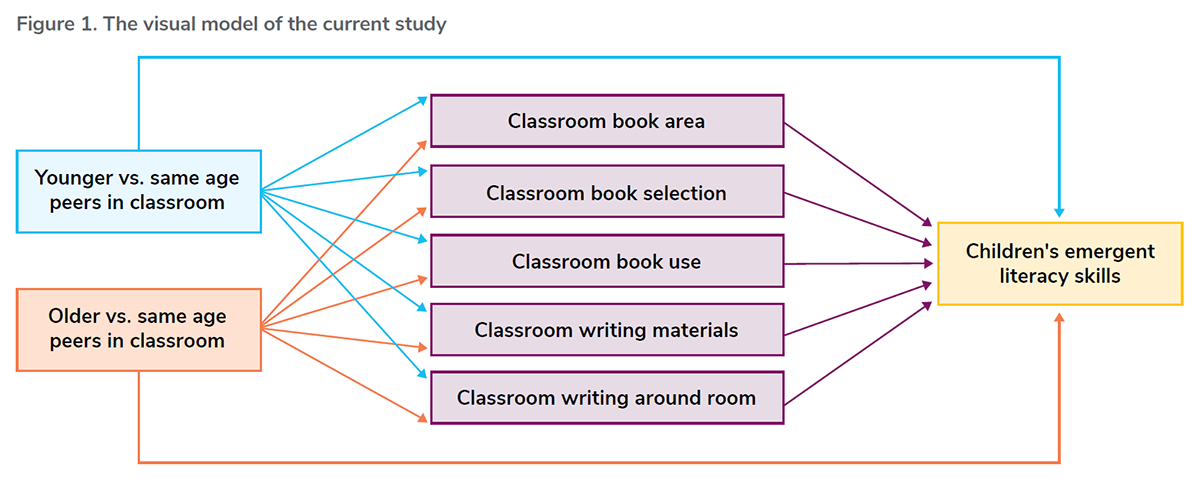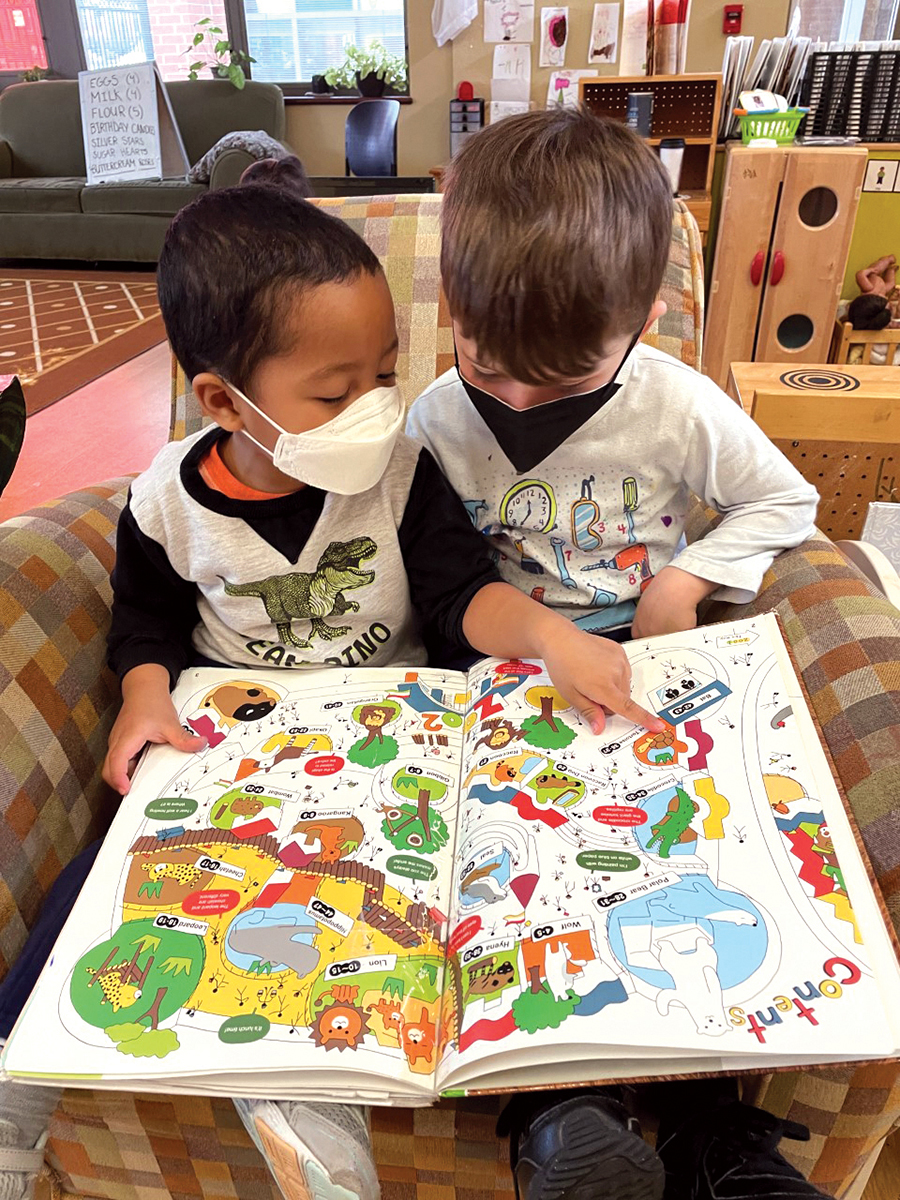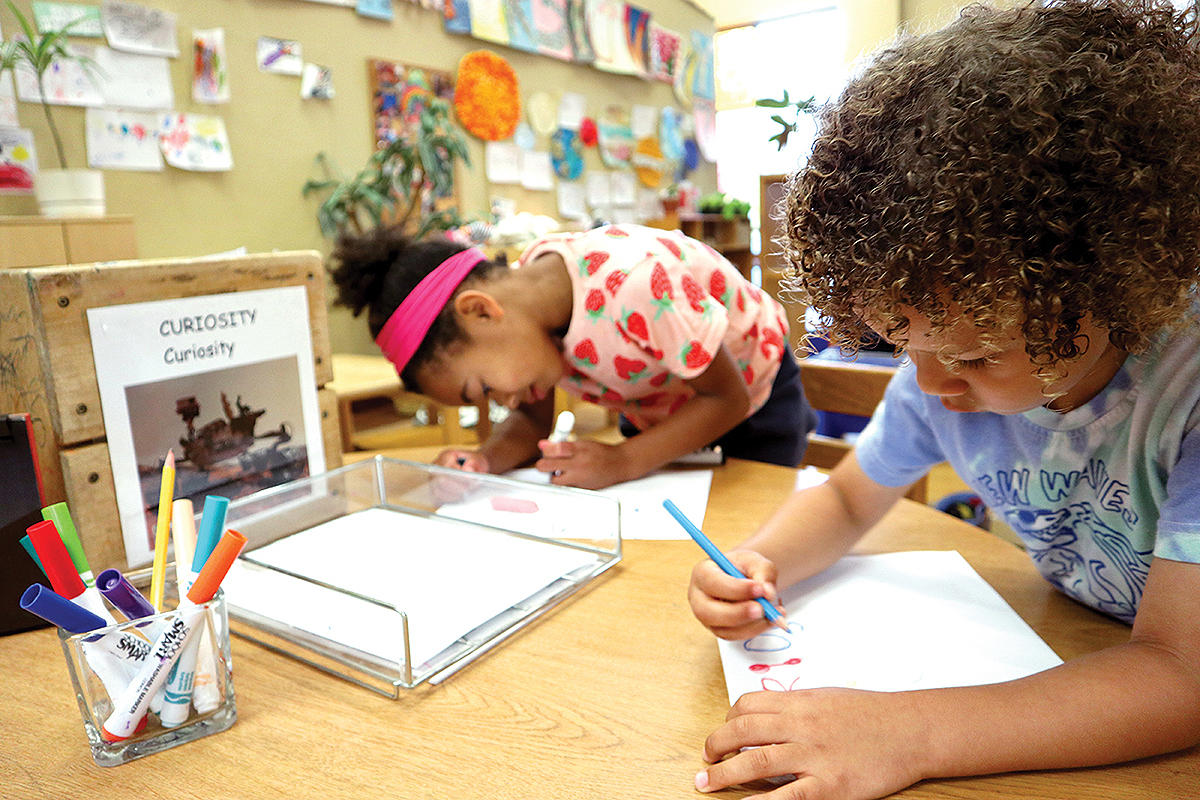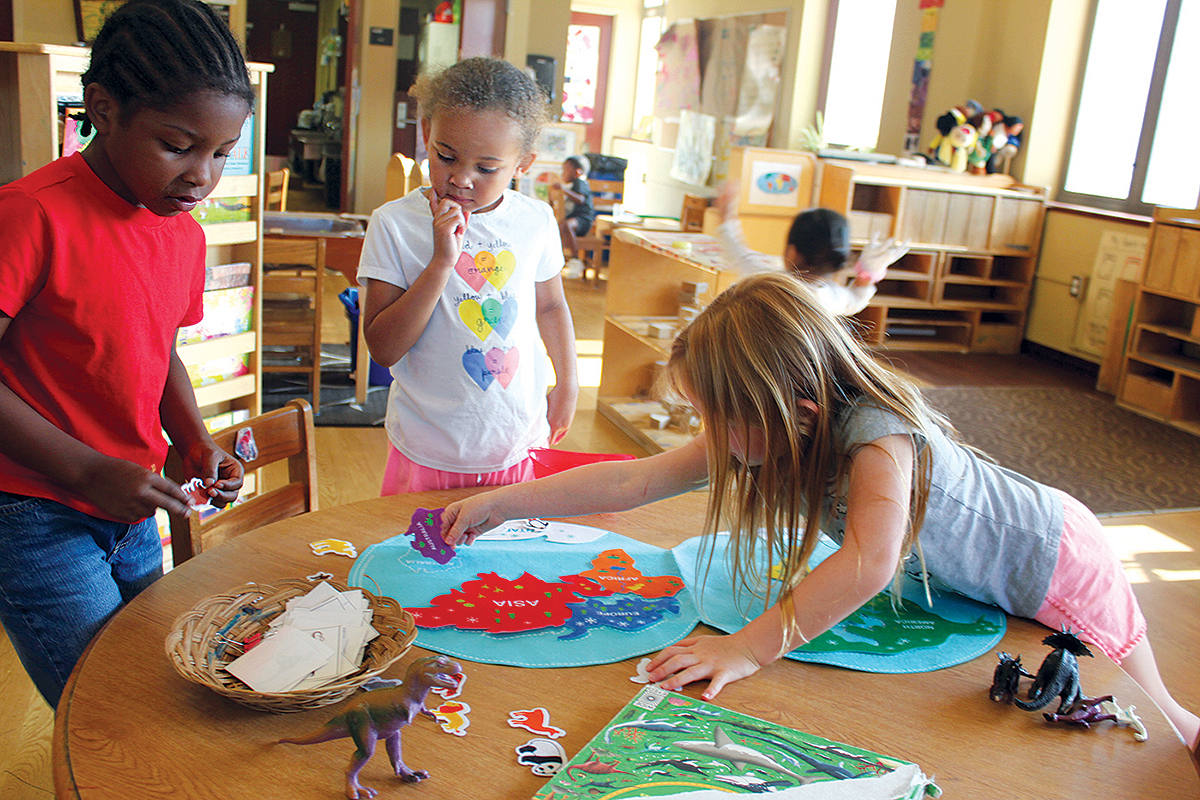AUTHORS: Qingqing Yang, Ph.D.; Kathryn Zimmermann, M.S.; Kelly M. Purtell, Ph.D.; Arya Ansari, Ph.D.
In early childhood, the development of emergent literacy skills, namely receptive vocabulary, expressive vocabulary, phonological awareness, and print knowledge, is critical (Pullen & Justice, 2003; Storch & Whitehurst, 2002). Receptive and expressive vocabulary (the ability to understand and express oneself using words); phonological awareness (noticing and manipulating the sounds in words), and print knowledge (recognizing the rules and forms of written language), are all important for learning to read and write well (Dickinson et al., 2019; Kendeou et al., 2009; Levy et al., 2006). Struggling in any of these areas may lead to lower academic growth (Pullen & Justice, 2003). High-quality preschool programs can play a critical role in promoting these emergent literacy skills, setting the stage for future school success (Pullen & Justice, 2003).
One factor that shapes children’s emergent literacy skills is the way that preschool teachers structure and arrange, in their classrooms, the display of items with writing on them — what researchers call the physical literacy environment (Guo et al., 2012). A high-quality physical literacy environment features a diverse selection of books, including books of varying difficulty levels and genres (e.g., rhyming texts, alphabet books, lift-the-flap books), related to different topics of instruction, and in good condition.
This environment also includes a dedicated book area, intentional book placement in various activity centers (e.g., pretend play areas, the block center, the science table), and easy accessibility for children (Justice, 2006). In addition, classrooms with a high-quality physical literacy environment provide designated areas with writing materials that promote and model writing (e.g., newspapers, maps; Guo et al., 2012; Neuman & Roskos, 1990), as well as writing displays around the room showing teacher- and child-directed writing and print products used to guide daily learning (e.g., signs, posters, writing samples; Guo et al., 2012; Phillips et al., 2008).
Despite the promising evidence regarding the importance of the physical literacy environment for children’s emergent literacy skills, there is little research on the factors that influence the quality of the physical literacy environment. Many children in the U.S. are enrolled in mixed-age preschool classrooms, which can include 2-, 3-, 4-, and 5-years-olds (Moiduddin et al., 2012). Teachers’ beliefs about the skill levels and developmental needs of differently aged children in these mixed-age classrooms may influence the way they set up the physical literacy environment (Lynch, 2009). For example, teachers who believe that younger children need less literacy-related instruction (Powell et al., 2008) may provide fewer literacy-related materials and spaces when teaching in classrooms with a higher percentage of younger children.
Although previous studies have found that older children in classrooms with a higher proportion of younger peers may gain less in emergent literacy skills (Ansari et al., 2016; Purtell & Ansari, 2018), the reasons behind these associations are not clear. Therefore, this study investigated whether the physical literacy environment is set up differently in mixed-age classrooms where there are more younger children (ages 2 and 3) compared to classrooms with a higher proportion of older children (ages 4 and 5) and whether these differences shape 4-year-olds’ emergent literacy development. We looked at five aspects of the literacy environment: the book area, book selection, book use, writing materials, and writing displays around the room. A visual model of the study is shown in Figure 1. Better understanding of these associations is critical to ensure that preschool programs with mixed-age classrooms effectively support the development of early skills necessary for successful reading and writing.


DATA & METHODS
We used data from the Professional Development Study (PDS) by the National Center for Research on Early Childhood Education (NCRECE; Hamre et al., 2012; Pianta et al., 2017). The PDS is a longitudinal, randomized controlled trial assessing early childhood education teacher professional development interventions. Details of the study are available here.
The current study involved 895 preschool children (mean age = 4.11 years) and 223 lead teachers (mean age = 42.56 years). These participants were recruited from multiple Head Start and publicly funded preschool programs across 10 sites in 8 states. The majority of participating children were 4 years old. Nearly half of children (47%) were identified as Black/African American, 14% as white, 35% as Hispanic/Latine, and 9% as other. Children’s families had an average annual household income of approximately $23,948, in a range from $2,500 to $87,500. Participating teachers were also diverse in terms of race/ethnicity (47% Black/African American, 33% white, 12% Hispanic/Latine, and 8% other). More than half of the classrooms (55%) were Head Start programs, and 35% were public pre-kindergartens. The majority of the classrooms (91.5%) contained more than one age group (2-3-year-olds, 4-year-olds, 5-year-olds).
Teacher reports of the number of 2-, 3-, 4-, and 5-year-old children in their classrooms was used to calculate the percentages of each age group per classroom. Each classroom was observed using the literacy environment checklist to assess the language-and-literacy-related materials and spaces children were exposed to in their classroom environments. This checklist assesses the classroom physical literacy environment in terms of the book area, book selection, book use, writing materials, and writing around the room. Details on the checklist can be found in Table 1. Children completed assessments of receptive vocabulary, expressive vocabulary, phonological awareness, and print knowledge in the fall and spring of their preschool year.
| Definition | # of items | Sample items | Range | |
|---|---|---|---|---|
| Book area | The arrangement of book area | 3 | Does where the books are located have soft materials? | 0-3 |
| Book selection | The number, variety, and condition of books | 4 | Do the books in the classroom range in different level? | 0-8 |
| Book use | The placement and accessibility of books | 5 | How many books are available in the science area? | 0-9 |
| Writing materials | Materials provided to encourage writing | 6 | Is an alphabet visible? | 0-8 |
| Writing around the room | The presence of teacher- and child-directed writing displays, writing tools and props around the room, and alphabet/word puzzles | 7 | How many varieties of teacher direction are on display in the classroom? | 0-13 |
KEY FINDINGS
Classrooms with more 2- and 3-year-olds provide less language and literacy materials and spaces
In this study, children in classrooms with a higher percentage of 2- and 3-year-olds had access to fewer books in different activity centers, fewer writing materials, and fewer writing tools and props on display. One possible explanation for these findings is that teachers in these classrooms may design the physical literacy environment according to their understanding of the needs of younger children. However, such beliefs may not be developmentally appropriate, as studies have shown that children as young as 3 have the capacity to develop writing knowledge and skills, including organizing writing units/marks in straight lines, using spaces to separate words, and applying accurate directionality while writing (Puranik & Lonigan, 2011).
Lack of writing on display around the room explains children’s lower gains in expressive vocabulary in classrooms with more 2- and 3-year-olds
Our findings also show that children in classrooms with a higher proportion of younger peers, compared with same-age or older peers, were less likely to be exposed to writing around the classroom, which in turn, was associated with smaller gains in their expressive vocabulary. The role of writing around the classroom can be understood from two perspectives. First, seeing more writing (e.g., posters, signs, teacher and child writing samples) around the classroom may create more prompts for children to practice and learn expressive vocabulary. This is because these writing displays are usually designed to enrich children’s learning experiences, relating either to the classroom theme or to children’s daily life. Second, writing around the room, especially child-directed writing displays, can be viewed as evidence of writing-related activities that occur in the classroom (Quinn et al., 2022). Participating in these activities also provides children with opportunities to learn different vocabulary (Zhang et al., 2015). This finding suggests that one or both of these mechanisms may be particularly important to young children’s vocabulary development.
When taken together, our findings indicate that classrooms with a higher proportion of younger children may provide less book use, fewer writing materials, and less writing around the room. The lower amounts of writing displayed around the room may be one potential reason why 4-year-olds in these classrooms have smaller expressive vocabulary gains. These findings highlight the importance of enhancing the physical literacy environment to meet the needs of all children in mixed-age classrooms.


RECOMMENDATIONS
Teachers and Practitioners
Rethink the design of the physical literacy environment, ensuring that high-quality materials are available to all children regardless of the age composition of the classroom. Our study indicates that older children lack an adequate physical literacy environment in classrooms with a higher percentage of 2- and 3-year-olds, hindering their emergent literacy development. To address this issue, it is essential to furnish these classrooms with more enriching resources such as books, writing materials, and writing displays to support the development of emergent literacy skills. Although we mainly looked at the emergent literacy skills of 4-year-olds, improvements in the physical literacy environment are likely to benefit children of all ages.
Researchers
Continue to investigate the reasons classroom age composition affects children’s language and literacy skills, as this may suggest other potential targets for promoting children’s language and literacy learning in mixed-age classrooms.
Explore how teachers and children interact with the physical literacy environment. This may provide more in-depth information on children’s emergent literacy learning experiences and illustrate how children of different ages shape their own interactive learning experiences.
Administrators and Policymakers
Prioritize the provision of resources to ensure all programs/classrooms have access to materials needed to create a high-quality learning environment. This may include increasing access to materials related to emergent literacy to support teachers in developing their physical literacy environments.
Provide professional development focused on the design and arrangement of the classroom physical literacy environment. Our study suggests that classrooms with a higher concentration of 2- and 3-year-olds tend to have fewer language and literacy materials and spaces. Accordingly, it is important to provide training on how to create a literacy environment that will benefit children of all ages. This training may cover designing an enriching reading environment, providing a variety of books in different genres and on different topics, ensuring children have access to books in different play areas, and providing enough writing materials and writing props.
AUTHOR NOTE:
The activities of the Crane Center for Early Childhood Research and Policy are supported in part by a generous gift of the Crane family to The Ohio State University. Correspondence about this work may be addressed to Kelly Purtell. Email: purtell.15@osu.edu.
The recommended citation for this paper is:
Yang, Q., Zimmermann, K., Purtell, K.M., Ansari, A. (2024). Preschool Classroom Age Composition, the Physical Literacy Environment, and Children’s Emergent Literacy Skills. Columbus, Ohio: Crane Center for Early Childhood Research and Policy & The Ohio State University.
ACKNOWLEDGMENT:
The authors would like to extend a very special thank you to the teachers of the A. Sophie Rogers School for Early Learning for providing the images of high-quality early learning environments that were used in this report. They would also like to thank to Rebecca Dore for brief edits, Michael Meckler for copy edits and dissemination, and Cathy Kupsky for designing this brief.

REFERENCES:
Ansari, A., Purtell, K., & Gershoff, E. (2016). Classroom age composition and the school readiness of 3- and 4-year-olds in the Head Start program. Psychological Science, 27(1), 53–63. https://doi.org/10.1177/0956797615610882
Dickinson, D. K., Nesbitt, K. T., & Hofer, K. G. (2019). Effects of language on initial reading: Direct and indirect associations between code and language from preschool to first grade. Early Childhood Research Quarterly, 49, 122–137. https://doi.org/10.1016/j.ecresq.2019.04.005
Guo, Y., Justice, L. M., Kaderavek, J. N., & McGinty, A. (2012). The literacy environment of preschool classrooms: Contributions to children’s emergent literacy growth: CLASSROOM LITERACY ENVIRONMENT. Journal of Research in Reading, 35(3), 308–327. https://doi.org/10.1111/j.1467-9817.2010.01467.x
Hamre, B. K., Pianta, R. C., Burchinal, M., Field, S., LoCasale-Crouch, J., Downer, J. T., Howes, C., LaParo, K., & Scott-Little, C. (2012). A Course on Effective Teacher-Child Interactions: Effects on Teacher Beliefs, Knowledge, and Observed Practice. American Educational Research Journal, 49(1), 88–123. https://doi.org/10.3102/0002831211434596
Justice, L. M. (2006). Evidence-based practice, response to intervention, and the prevention of reading difficulties. Language, Speech, and Hearing Services in Schools, 37(4), 284–297. https://doi.org/10.1044/0161-1461
Kendeou, P., van den Broek, P., White, M. J., & Lynch, J. S. (20091102). Predicting reading comprehension in early elementary school: The independent contributions of oral language and decoding skills. Journal of Educational Psychology, 101(4), 765. https://doi.org/10.1037/a0015956
Levy, B. A., Gong, Z., Hessels, S., Evans, M. A., & Jared, D. (2006). Understanding print: Early reading development and the contributions of home literacy experiences. Journal of Experimental
Child Psychology, 93(1), 63–93. https://doi.org/10.1016/j.jecp.2005.07.003
Lynch, J. (2009). Preschool teachers’ beliefs about children’s print literacy development. Early Years, 29(2), 191–203. https://doi.org/10.1080/09575140802628743
Moiduddin, E., Aikens, N., Tarullo, L., West, J., & Xue, Y. (2012). Child Outcomes and Classroom Quality in FACES 2009. Office of Planning, Research, and Evaluation, U.S. Department of Health and Human Services.
Neuman, S. B., & Roskos, K. (1990). Play, Print, and Purpose: Enriching Play Environments for Literacy Development. The Reading Teacher, 44(3), 214–221.
Phillips, B. M., Clancy-Menchetti, J., & Lonigan, C. J. (2008). Successful Phonological Awareness Instruction With Preschool Children: Lessons From the Classroom. Topics in Early Childhood Special Education, 28(1), 3–17. https://doi.org/10.1177/0271121407313813
Pianta, R., Hamre, B., Downer, J., Burchinal, M., Williford, A., LoCasale-Crouch, J., Howes, C., Paro, K. L., & Scott-Little, C. (2017). Early Childhood Professional Development: Coaching and Coursework Effects on Indicators of Children’s School Readiness. Early Education and Development, 28(8), 956–975. https://doi.org/10.1080/10409289.2017.1319783
Powell, D. R., Burchinal, M. R., File, N., & Kontos, S. (2008). An ecobehavioral analysis of children’s engagement in urban public school preschool classrooms. Early Childhood Research Quarterly, 23(1), 108–123. https://doi.org/10.1016/j.ecresq.2007.04.001
Pullen, P. C., & Justice, L. M. (2003). Enhancing Phonological Awareness, Print Awareness, and Oral Language Skills in Preschool Children. Intervention in School and Clinic, 39(2), 87–98. https://doi.org/10.1177/10534512030390020401
Puranik, C. S., & Lonigan, C. J. (2011). From Scribbles to Scrabble: Preschool Children’s Developing Knowledge of Written Language. Reading and Writing, 24(5), 567–589. https://doi.org/10.1007/s11145-009-9220-8
Purtell, K. M., & Ansari, A. (2018). Classroom Age Composition and Preschoolers’ School Readiness: The Implications of Classroom Quality and Teacher Qualifications. AERA Open, 4(1), 2332858418758300. https://doi.org/10.1177/2332858418758300
Quinn, M. F., Gerde, H. K., & Bingham, G. E. (2022). Who, What, and Where: Classroom Contexts for Preschool Writing Experiences. Early Education and Development, 33(8), 1439–1460. https://doi.org/10.1080/10409289.2021.1979834
Storch, S. A., & Whitehurst, G. J. (2002). Oral language and code-related precursors to reading: Evidence from a longitudinal structural model. Developmental Psychology, 38(6), 934–947. https://doi.org/10.1037/0012-1649.38.6.934
Zhang, C., Hur, J., Diamond, K. E., & Powell, D. (2015). Classroom writing environments and children’s early writing skills: An observational study in Head Start classrooms. Early Childhood Education Journal, 43(4), 307–315. https://doi.org/10.1007/s10643-014-0655-4

